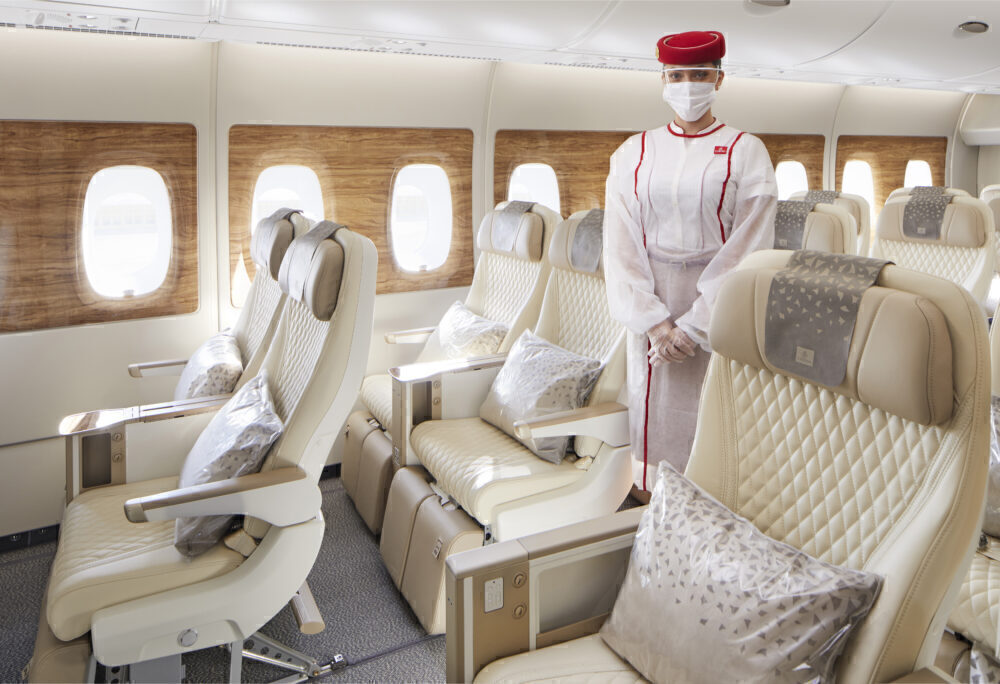Like most airlines around the world, Emirates has stringent requirements and high demands of its cabin crew. With eight weeks of training for new recruits, what goes into training the cabin crew for one of the world’s most highly-regarded carriers?

An international team
In a 2018 recruitment fact sheet, Emirates notes that its cabin crew had been recruited from over 135 countries, speaking more than 60 languages. In that year, Emirates had employed over 23,000 cabin crew members- all having been trained at the Emirates Aviation College Cabin Crew Training, which was opened in the summer of 2007.




Flying all over the world serving passengers on Emirates airlines is surely a challenging job. While at times glamorous, the work can also be demanding. As such, Emirates requires that applicants be at least 21 years old with a minimum height of 160 cm (5′ 3″). Along with a few other requirements, let’s look at what successful candidates can expect during their training…
Eight weeks of “basic training”
For completely new recruits, Emirates says that its training takes place over eight weeks on the two aircraft operated by the airline: The Boeing 777 and A380. The training is divided into five broad sections:
- Evacuation and Safety & Emergency Procedures: Becoming familiar with safety scenarios from emergency decompression, to evacuation on water and land using aircraft simulators. Dealing with door malfunctions, encountering slide failures, and fighting various types of fires are also part of this training. Safety training is reviewed annually during a two-day course.
- Group Medical Training: Satisfying regulatory requirements, medical training includes inflight medical care and basic life support.
- Security Training: This includes security checks and learning the protocols for hijacking situations, sabotage, and handling disruptive passengers through conflict resolution and de-escalation.
- Cabin Service Training: Emirates describes this saying, “cabin crew are comprehensively taught to provide the very best in-flight service, from full silver service fine dining to mixing the perfect cocktail, delivering the Emirates on-board experience.” This section also includes familiarization with aircraft toilet facilities as well as galleys and aircraft seating.
- Image and Uniform: This portion of training outlines the airline’s standards for hair, make-up, skin care, nail care, and uniform. Interestingly, this unit provides the cabin crew with guidance on how to maintain a healthy lifestyle while flying.
- Duty-Free Sales: This training takes place in a specially designed room, where cabin crew are introduced to available items and “taught the skills needed to sell one of the most successful product ranges in the air.” This has been modified since the global health crisis.




Ongoing training
While the eight weeks of basic training will allow crew members to begin serving flights in economy class, additional courses will come over the course of an Emirates flight attendant’s career. They include:
- Business class training: This can be taken after 12-18 months of work.
- First class training: Members are eligible for this after 24 months.
- Cabin supervisor: This is available only after two and a half to three years of service as a cabin crew member with a prerequisite being time spent working as a First Class flight attendant.
- Purser: Responsible for managing staff in all three cabins, and the direct liason with the Captain, this role requires “six months of ‘on-the-job’ training [and] completion of a portfolio of tasks and courses…”
Adapting to the global health crisis
Of course, training has been modified since COVID-19 emerged. Inflight changes include:
- The wearing of personal protective equipment (PPE) such as face masks, face sheilds, and protective gowns.
- Increased lavatory disinfection
- Enforcing the airline’s mandatory mask policy for passengers
Additionally, for the airline’s Duty Free sales, paper magazine catalogs are now hygienically wrapped and must be requested. Flight attendants are not able to open or demonstrate products at the moment.
Clearly, the job of cabin crew is tough work – and certainly includes more than just a safety demonstration and serving meals. Other airlines have fairly similar training programs. Simple Flying partnered with Eventful Globe in December 2020 to provide an insight into Singapore Airlines’ cabin crew training experience.
Have you ever considered becoming a flight attendant? Let us know in the comments.



